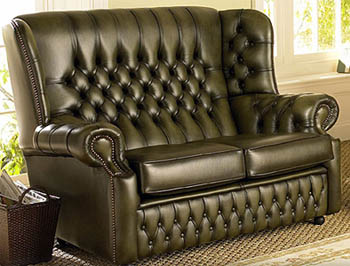British buttons: Chesterfield style is back
 Wiesbaden - Buttons makes a difference: Positioned precisely in upholstery or leather, they give a sofa or chair a sense of dignity.
Wiesbaden - Buttons makes a difference: Positioned precisely in upholstery or leather, they give a sofa or chair a sense of dignity.
Known as Chesterfield, the style in which the evenly-spaced buttons form a pattern, originated in Britain. To Ursula Geismann of Germany's furniture industry association it conjures up images of dark and heavy furniture.
"Today this style of furniture looks significantly lighter," said Geismann. New interpretations are defining the style's currant image, which is reminiscent of historical examples - depending on the designer, sometimes more, sometimes less. No one can deny their penchant for nostalgia, and the scope of the style stretches from the simple elegance of the 1920s through the hippy look all the way through angular models popular in the 1980s.
Lots of black and white and a little bit of brown and beige are the preferred colours - all very classic. In addition, the new Chesterfields are a sign of the longing for old virtues, according to design experts. Irene Fromberger, a design consultant in Wiesbaden, refers to it as a value- conscious mega trend.
But the swerve toward the traditional should not be confused with smugness. The new classic look has a very urbane style that is "contemporary, but not trendy," said Fromberger.
While their forebearers were chunky and dignified, the new editions are thoroughly humourous. The noble impression of Monseigneur, a chair by Philippe Starck, with its front arms and legs of steel, is interrupted by wooden back legs.
The German furniture manufacturer Bretz takes things in the opposite direction. Its sofa Marilyn and lounge chair Pompadour bring a measured portion of splendour into the home. Mother-of-pearl, gold or platinum leather are accented by Swarovski crystal fasteners.
The Chesterfield style can also be expressed extremely modestly. Hella Jongerius of Holland used clear lines in designing the sofa Polder for Vitra in discreet colours and precisely positioned buttons.
Somewhere between the communal living look and the style found in grandma's living-room lie the Bohemian sofas and chairs designed by Patricia Urquiola for the Italian manufacturer Moroso. Light or dark brown leather is sewn into crumpled comfort furniture. An especially decorative variation of Chesterfield is shown in the series My Beautiful Backside, also from Moroso. Tight upholstery and pillows are accented by a few strategically positioned buttons.
The lines Privée by Cassina of Italy and Edwards of the Austrian manufacturer Wittmann - a resurrection of a design from 1981 - go in the classical direction. The demanding technique of placing the buttons provides the manufacturer a chance to show its handiwork, according to Karin Schrey of Wittmann in describing the attraction of the line.
Chesterfield's comeback can be recognized in the fact that it's not found just in luxury brands.
"Quality craftsmanship is important again. That's also true in low-priced brands," said Fromberger. Discount furniture manufacturers and their cousins have Chesterfield designs in their lines. Ikea, for example, has brought out the sofa Karstad, which comes not only in a version with shiny upholstery, but also with a quilted cover.
"Straightforward, simple, ageless and modern," were the requirements designer Tord Bjoerklund tried to meet with his design. With it he's placed faith in the design scheme that most of his fellow designers have embraced, showing that the British-inspired button upholstery work is no longer just a niche design.
In fact while the button work - known as capitonné among specialists - is most commonly found in furniture for seating, the current trend apparently has given home furnishing designers a new idea. The French duo Ionna Vautrin and Guillaume Delvigne, for example, have designed a vase whose surface appears to be quilted. Kiki van Eijk of Holland also implemented the Chesterfield look in a porcelain tower-like dresser with knobs made of real gold. (dpa)